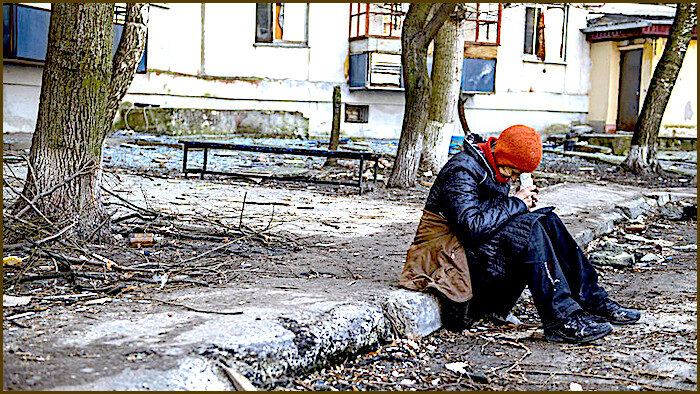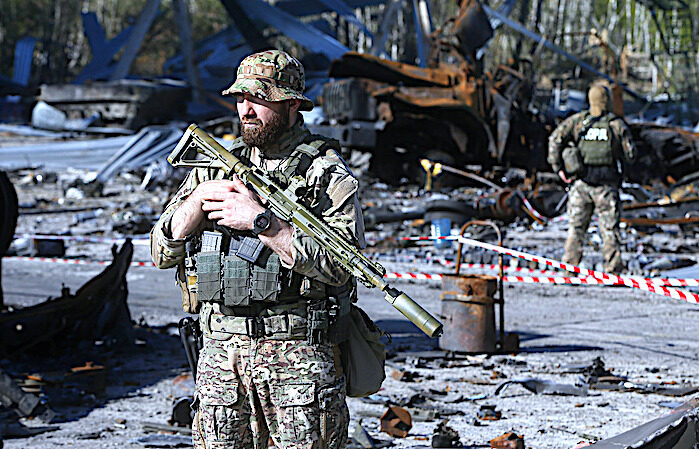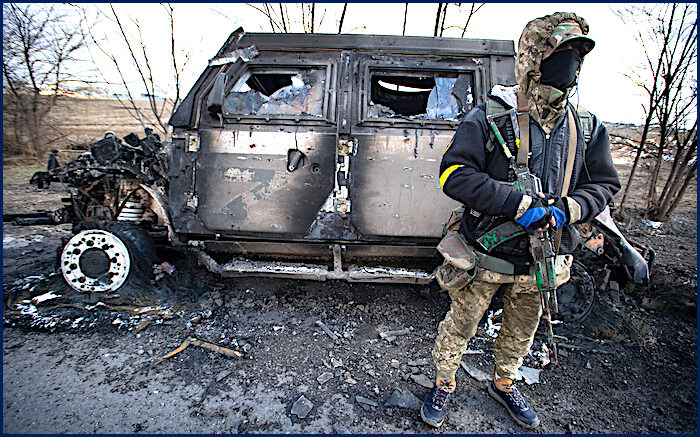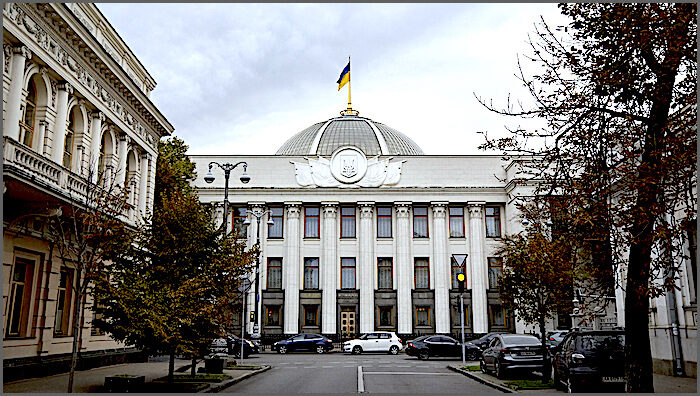
These include the towns of Balakleya, Izium, Kupiansk, Volchansk and a number of villages and small locales. Nevertheless, the Russian army, by concentrating on rearguard battles, was able to avoid significant losses and managed to retreat to the left bank of the Oskol River to regroup.
However, the primary victims of this turn of events were the inhabitants of the aforementioned areas who are now in the hands of Ukraine.
Left behind
There is no exact information about the population of this region. The last census was conducted by Kiev more than 20 years ago, and the country's statistics are known to be wildly inaccurate.
At the outset, we can estimate the pre-war population at 200,000 people. After the outbreak of hostilities, some were forced to flee. The number of refugees depended on the intensity of the fighting. For example, in the Russia-border town of Volchansk, people continued to live normally - they had not heard firing in the city since March - and there has always been humanitarian aid. However, the frontline villages south of Izium were virtually wiped off the face of the earth.
In any case, we are talking about tens of thousands of people. Most likely, at least 100,000 people lived in the Russian-controlled territories. Some of them remain under the protection of the Russian army, which controls the left bank of the Oskol, and villages such as Kupiansk-Uzlovoi and Borovaya, which have now become the sites of intense hostilities.
After the beginning of the Ukrainian offensive, some Kharkov Region residents were forced to leave their homes. An evacuation was carried out in Volchansk, Veliky Burluk, Kupiansk and Izium. Various estimates suggest that between 5,000 and 25,000 people have fled to Russia in September alone.
According to Readovka journalists, Voronezh Region accommodated about a thousand refugees. Another small number left Kharkov and headed to the Donetsk and Lugansk People's Republics, in particular to the nearest district center of Svatovo.
In any case, most local residents have remained in situ. Based on the communication with residents of small Donbass front-line towns that have been shelled for eight years, it is safe to say that such a decision is not politically motivated. Residents of such areas, many of whom are older people, those with disabilities, families with household plots or low-mobility relatives who require care, usually cling to their land, homes and traditional way of life to the end. They are the ones who have not evacuated their homes in recent months, and it is they who are now under threat.
Ukraine is preparing 'mop-ups'
A number of channels have appeared in the Telegram messenger app, one of the leading social media platforms for both sides of the conflict, which publish the personal data of so-called "collaborators." The basis for accusations could be anything, including communicating with the Russian military or receiving humanitarian aid. Some of these channels are currently blocked, after a wave of complaints to Telegram's technical support.
Despite this, some remain operational and many dehumanize Russia's supporters as "zhduny(rus) - waiters." According to the public consensus in Ukraine, such people who sympathize with Moscow are the cause of the conflict. In the eyes of Ukrainian radicals, anyone who expresses a positive attitude towards Russia is a threat to national security.
Thus, personal data in the early days of the offensive was published for one purpose: to point out enemies so that they would be killed during the "sweep" - a set of actions aimed at establishing control over occupied territory undertaken by the army, mercenaries and nationalist battalions. 'Mopping-up' is outside the criminal procedure code and is not regulated by any laws. Law may come to the territory later but, in the very first days, "revolutionary justice" is carried out, without lawyers and with the functions of judge, prosecutor and executioner performed by Ukrainian combatants.
To help their murderous cause, similar channels are being created that publish personal data with calls for lynching.
After the 'cleansing' is completed, elements of the Ukrainian legal system will come to the captured cities. They will focus on the concealment of war crimes committed during the 'clean-up', and instead point the finger at Russia. The last two tasks will be carried out simultaneously, such as in Bucha, and those killed by Ukrainians will be cynically presented as victims of the Russian army.
Demonstrative detentions
According to the Security Service of Ukraine (SBU), as of last week 16 people suspected of collaborating with Russian authorities had already been detained. The security agents are first and foremost interested in tax officials responsible for the functioning of local businesses during Moscow's control of the territory. However, local teachers who switched to teaching the Russian curriculum are also at risk.
Despite international humanitarian law, which obliges the party in control of a territory to preserve the educational process and emphasizes that no harm be done to educators, Kiev seems determined to punish teachers, to use them as an example to others.
Deputy Prime Minister of Ukraine Irina Vereshchuk says that these teachers committed crimes and should be punished for high treason. Such measures by the Ukrainian government are aimed primarily at intimidating educators in Russian-controlled territory. By showing a willingness to prosecute civilian workers, Kiev is raising the stakes.
Ukrainian law enforcement is also known to detain forestry workers, for having helped the Russian army to collect firewood. The details are unknown: whether they supplied the Russians with firewood on a commercial basis, felled the forests entrusted to them, or simply told the soldiers where to chop, remains unknown.
Traditions of Ukrainian 'justice'
Any civilian living in Russian-controlled territory could be charged with collaboration. Ukraine has a special ministry for the reintegration of "temporarily occupied territories," which since 2016 has been developing a policy of "filtering" the civilian population. Initially, its activity was concentrated around Donbass and Crimea but its scope has now expanded.
The most striking example is the law 'On the State Policy of the Transitional Period', which has been criticized by, among others, the Venice Commission [on constitutional law] for the fact that Ukrainian state policy in the territories it occupies is aimed at investigating only the alleged war crimes of the opposite side, ignoring the goal of establishing the truth about all crimes. This law also introduced differentiated treatment of citizens, depending on their level of interaction with Russia and/or the Donbass republics.
The topic of differentiating guilt - and, according to Ukraine, the entire civilian population is guilty to a greater or lesser degree - was then promoted by all sorts of non-profit organizations. So the Crimean Tatar Resource Center engaged with the Soros Foundation's 'Vozrozhdeniye' and the extremist organization 'Mejlis of the Crimean Tatar people,' who claim to be the exiled Ukrainian government of Crimea, developed a whole methodology for evaluating the degree of collaboration.
For a demonstration of this scale, Ukrainians cited three respective examples: a doctor at a Crimean city hospital, an acting city council deputy and the ex-chief prosecutor of Crimea, Natalya Poklonskaya.
According to the methodology, the doctor scores 17 points, the deputy 30, and Poklonskaya 86. Thus, any Crimean doctor is already guilty of collaborationism, having 17 points. Since 2014, Ukrainian society, represented by non-profit organizations, has debated the doctor's degree of guilt and the punishment which ought be meted out. We see the results of such discussions in Kharkov Region.
Preparing the 'next Bucha'
In addition to fighting teachers and foresters, Ukrainian law enforcement and the media are also busy falsifying war crimes. They open the so-called "cellars" - illegal prisons and torture chambers, in which alleged prisoners of war and civilians were kept. The process of falsification relies on vivid shots - frames with a prayer scratched on the wall of one of the basements.
Another fabrication involved seven Sri Lankan students attending the Kupiansky Medical College, which was allegedly held by Russian military personnel since March, who testified about torture by the Russians.
The official position is simple: angry Russians simply detained and tortured foreigners. That the Russian army in fact evacuated them from Mariupol and Kherson is ignored. For the time being, Sri Lanka's Ministry of Foreign Affairs is asking Kiev to provide more information about its citizens. A fair investigation, however, should not be expected until those Sri Lankans find themselves outside the hands of the Ukrainian state.
Speaking of Kiev's hand, another media symbol of the "genocide of the Ukrainian people" was presented as the hand of a deceased man with rubber bracelets in the colors of the Ukrainian flag. This was apparent evidence of a hate crime: a man killed for wearing Ukrainian symbols. As it turned out, the body was that of Sergey Sova, a member of the 93rd Mechanized Brigade, who was killed during fighting near Izium.
In general, the only mass graves that Ukrainian propaganda now clings to are the cemeteries organized by Russians, where the victims of the military conflict were buried, including Ukrainian soldiers. There is an inscription on one of the crosses, in particular, "APU [Ukrainian Armed Forces] 17 people, Izium, from the morgue." Ukrainians claim that there are 440 bodies there. Some of the crosses have memorial plaques, some only an inventory number.
The bodies were buried by the Russian army in accordance with the traditions of the region. Perhaps, of course, among those buried under the cross are Muslims, Jews, or adherents to pagan beliefs popular among Ukrainian neo-Nazi battalions, but the Russians did everything possible on their part to ensure the remains of the enemy were not desecrated.
In normal circumstances, these bodies would have been given to the Ukrainian side in return for the bodies of dead Russian soldiers, but Ukraine boycotted these exchanges due to an unwillingness to admit significant losses. In particular, the son of the aforementioned Sergey Sova learned a few months later about the fate of his father and through the media requested the body be transferred back home for a proper burial. Prior to that, Sova had most likely been listed as missing, a ploy that suppresses official numbers of dead Ukrainian soldiers and avoids compensation payments to their families.

All of this is a sinister and cynical story, the truth of which we can learn only after the return of the Russian army to Kharkov. Only then will the massive machine of lies, propaganda and disinformation, which is the work of the Ukrainian government in the occupied territories, be broken, and the world will be able to learn about the real war criminals. As when we discovered after the liberation of Mariupol and the establishment of control over the buildings of Mariupol Airport, that the Ukrainian Security Service and Azov turned it into a concentration camp, known as 'The Library.'





Western backers REJOICE.
Western backers are western instigators, western war profiteers, western hypocrites, western murderers, western war criminals, western perpetrators of crimes against humanity.
Shame on the west. It is not the best, but the worst.